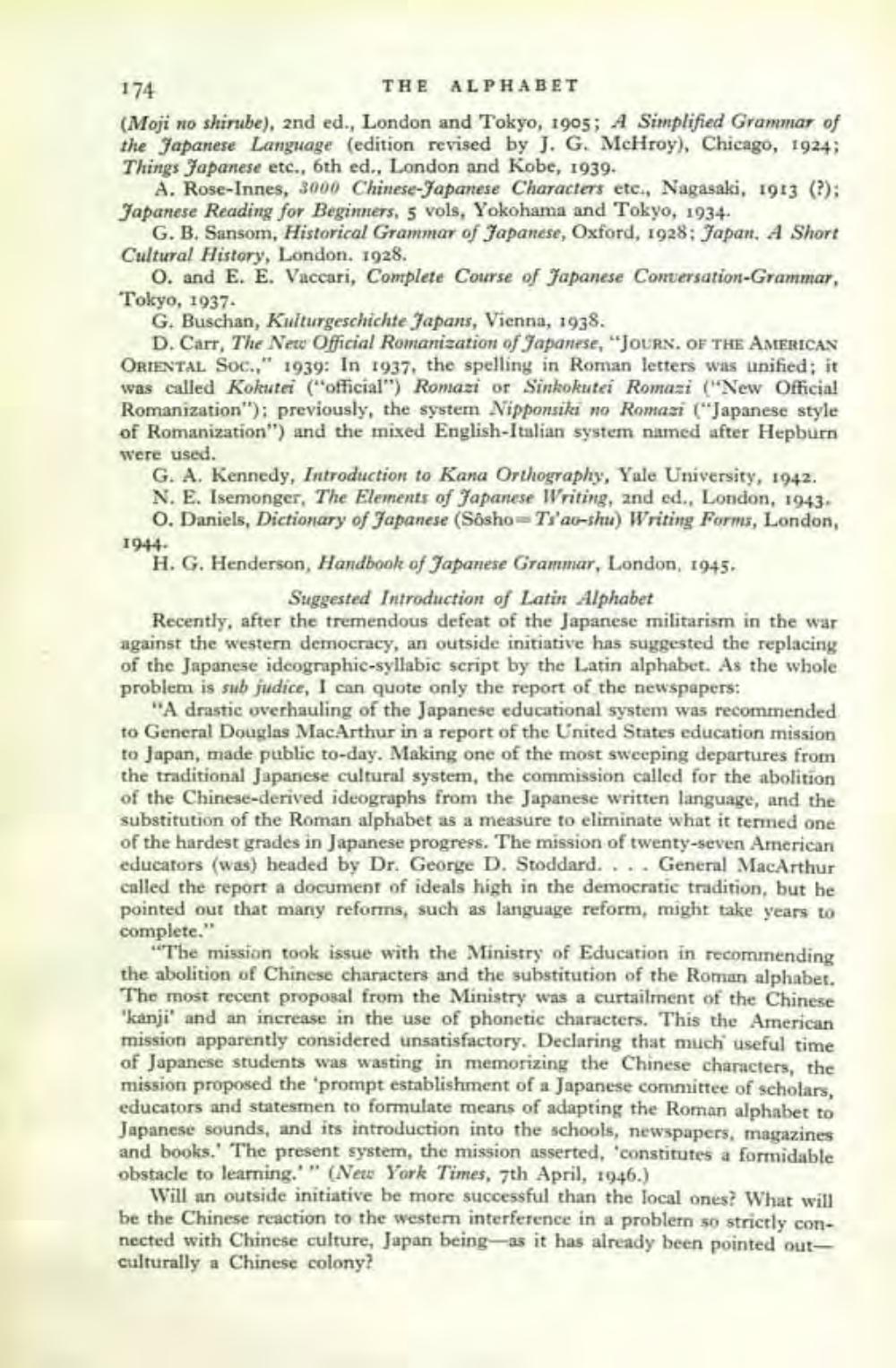________________
174
THE ALPHABET
(Moji no shirube), 2nd ed., London and Tokyo, 1905; A Simplified Grammar of the Japanese Language (edition revised by J. G. McHroy), Chicago, 1924; Things Japanese etc., 6th ed., London and Kobe, 1939.
A. Rose-Innes, 3000 Chinese-Japanese Characters etc., Nagasaki, 1913 (?): Japanese Reading for Beginners, 5 vols, Yokohama and Tokyo, 1934
G. B. Sansom, Historical Grammar of Japanese, Oxford, 1928; Japan, A Short Cultural History, London. 1928.
O. and E. E. Vaccari, Complete Course of Japanese Conversation-Grammar, Tokyo, 1937
G. Buschan, Kulturgeschichte Japans, Vienna, 1938.
D. Carr, The New Official Romanization of Japanese, "JOURN. OF THE AMERICAN ORIENTAL Soc., 1939: In 1937, the spelling in Roman letters was unified; it was called Kokutei ("official") Roniazi or Sinkokutei Romani ("New Official Romanization"); previously, the syster Nipponsiki no Romasi (Japanese style of Romanization") and the mixed English-Italian system named after Hepburn were used.
G. A. Kennedy, Introduction to Kana Orthography, Yale University, 1942. N. E. Isemonger, The Elements of Japanese Writing, and ed., London, 1943,
0. Daniels, Dictionary of Japanese (Sósho Ts'au-shu) Writing Forms, London, 1944H. G. Henderson, Handbook of Japanese Grammar, London, 1945,
Suggested Introduction of Latin Alphabet Recently, after the tremendous defeat of the Japanese militarism in the war against the western democracy, an outside initiative has suggested the replacing of the Japanese ideographic-syllabic script by the Latin alphabet. As the whole problem is sub fudice, I can quote only the report of the newspapers:
"A drastic overhauling of the Japanese educational system was recommended to General Douglas MacArthur in a report of the United States education mission to Japan, made public to-day. Making one of the most sweeping departures from the traditional Japanese cultural system, the commission called for the abolition of the Chinese-derived ideographs from the Japanese written language, and the substitution of the Roman alphabet as a measure to eliminate what it termed one of the hardest grades in Japanese progress. The mission of twenty-seven American educators (was) headed by Dr. George D. Stoddard.... General MacArthur called the report a document of ideals high in the democratic tradition, but be pointed out that many reforms, such as language reform, might take years to complete."
"The mission took issue with the Ministry of Education in recommending the abolition of Chinese characters and the substitution of the Roman alphaber. The most recent proposal from the Ministry was a curtailment of the Chinese kanji' and an increase in the use of phonetic characters. This the American mission apparently considered unsatisfactory. Declaring that much useful time of Japanese students was wasting in memorizing the Chinese characters, the mission proposed the 'prompt establishment of a Japanese committee of scholars. educators and statesmen to formulate means of adapting the Roman alphabet to Japanese sounds, and its introduction into the schools, newspapers, magazines and books. The present system, the mission asserted, 'constitutes a formidable obstacle to learning.'" (New York Times, 7th April, 1946.)
Will an outside initiative be more successful than the local ones? What will be the Chinese reaction to the western interference in a problem so strictly connected with Chinese culture, Japan being--as it has already been pointed outculturally a Chinese colony?




